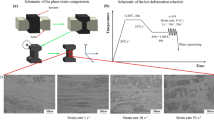The microstructural and mechanical properties of a low alloy steel due to variations of temperatures were studied theoretically in this paper. In particular, the effects of microstructure, phase fractions, and local composition and area of single phases on the micromechanical behavior were considered. Based on these effects, a micro–macroscopic model was adopted to describe the hardening and fracture behaviors of this steel under some heat treatments. It was demonstrated that the flow curves under different intercritical temperatures could be well predicted by such model. Further simulation results showed that the high stress concentrated on the martensites, and the appearance of shear bands strongly depended on phase microstructures. In addition, it was found that the simulations on true stress–true strain curves at a macroscale were adequate for the prediction of damage behavior in different steels.












Similar content being viewed by others
References
H. J. Jun, J. S. Kang, D. H. Seo, et al., “Effects of deformation and boron on microstructure and continuous cooling transformation in low carbon HSLA steels,” Mater. Sci. Eng. A, 422, No. 1, 157–162 (2006).
S. Oliver, T. B. Jones, and G. Fourlaris, “Dual phase versus TRIP strip steels: comparison of dynamic properties for automotive crash performance,” Mater. Sci. Technol., 23, No. 4, 423–431 (2007).
Y. I. Son, Y. K. Lee, K. T. Park, et al., “Ultrafine grained ferrite–martensite dual phase steels fabricated via equal channel angular pressing: microstructure and tensile properties,” Acta Mater., 53, No. 11, 3125–3134 (2005).
L. Shi, Z. Yan, Y. Liu, et al., “Improved toughness and ductility in ferrite/acicular ferrite dual-phase steel through intercritical heat treatment,” Mater. Sci. Eng. A, 590, 7–15 (2005).
J. Kang, C. Wang, G. D. Wang, “Microstructural characteristics and impact fracture behavior of a highstrength low-alloy steel treated by intercritical heat treatment,” Mater. Sci. Eng. A, 553, 96–104 (2012).
Z. J. Xie, S. F. Yuan, W. H. Zhou, et al., “Stabilization of retained austenite by the two-step intercritical heat treatment and its effect on the toughness of a low alloyed steel,” Mater. Des., 59, 193–198 (2014).
M. A. Maleque, Y. M. Poon, and H. H. Masjuki, “The effect of intercritical heat treatment on the mechanical properties of AISI 3115 steel,” J. Mater. Proc. Technol., 153, 482–487 (2004).
W. H. Zhou, X. L. Wang, P. K. C. Venkatsurya, et al., “Structure–mechanical property relationship in a high strength low carbon alloy steel processed by two-step intercritical annealing and intercritical tempering,” Mater. Sci. Eng. A, 607, 569–577 (2014).
M. Azuma, S. Goutianos, N. Hansen, et al., “Effect of hardness of martensite and ferrite on void formation in dual phase steel,” Mater. Sci. Technol., 28, No. 9, 1092–1100 (2012).
B. C. Hwang, T. Y. Cao, S. Y. Shin, et al., “Effects of ferrite grain size and martensite volume fraction on dynamic deformation behavior of 0.15C–2.0Mn–0.2Si dual phase steels,” Mater. Sci. Technol., 21, No. 8, 967–975 (2005).
A. Ramazani, K. Mukherjee, H. Quade, et al., “Correlation between 2D and 3D flow curve modelling of DP steels using a microstructure-based RVE approach,” Mater. Sci. Eng. A, 560, 129–139 (2013).
P. Phetlam and V. Uthaisangsuk, “Microstructure based flow stress modeling for quenched and tempered low alloy steel,” Mater. Des., 82, 189–199 (2015).
A. Ramazani, K. Mukherjee, U. Prahl, et al., “Modelling the effect of microstructural banding on the flow curve behavior of dual-phase (DP) steels,” Comput. Mater. Sci., 52, No. 1, 46–54 (2012).
M. R. Ayatollahi, A. C. Darabi, H. R. Chamani, et al., “3D micromechanical modeling of failure and damage evolution in dual phase steel based on a real 2D microstructure,” Acta Mech. Solids Sin., 29, No. 1, 95–110 (2016).
A. Ramazani, K. Mukherjee, A. Abdurakhmanov, et al., “Micro–macro-characterization and modelling of mechanical properties of gas metal arc welded (GMAW) DP600 steel,” Mater. Sci. Eng. A, 589, 1–14 (2014).
S. M. K. Hosseini, A. Zarei-Hanzaki, M. J. Y. Panah, et al., “ANN model for prediction of the effects of composition and process parameters on tensile strength and percent elongation of Si–Mn TRIP steels,” Mater Sci. Eng. A, 374, No. 1, 122–128 (2004).
M. I. Latypov, S. Shin, B. C. De Cooman, et al., “Micromechanical finite element analysis of strain partitioning in multiphase medium manganese TWIP+TRIP steel,” Acta Mater., 108, 219–228 (2016).
A. Ramazani, M. Abbasi, U. Prahl, et al., “Failure analysis of DP600 steel during the cross-die test,” Comput. Mater. Sci., 64, 101–105 (2012).
B. Berisha, C. Raemy, C. Becker, et al., “Multiscale modeling of failure initiation in a ferritic–pearlitic steel,” Acta Mater., 100, 191–201 (2015).
L. Gurson, “Continuum theory of ductile rupture by void nucleation and growth: Part I. Yield criteria and flow rules for porous ductile media,” J. Eng. Mater. Technol., 99, No. 1, 2–15 (1977).
V. Tvergaard and A. Needleman, “Analysis of the cup–cone fracture in a round tensile bar,” Acta Metall., 32, No. 1, 157–169 (1984).
A. Needleman and V. Tvergaard, “An analysis of ductile rupture modes at a crack tip,” J. Mech. Phys. Solids, 35, 151–183 (1987).
N. Vajragupta, V. Uthaisangsuk, B. Schmaling, et al., “A micromechanical damage simulation of dual phase steels using XFEM,” Comput. Mater. Sci., 54, 271–279 (2012).
M. Abendroth and M. Kuna, “Determination of deformation and failure properties of ductile materials by means of the small punch test and neural networks,” Comput. Mater. Sci., 28, No. 3, 633–644 (2003).
J. Faleskog, X. Gao, and C. F. Shih, “Cell model for nonlinear fracture analysis. I. Micromechanics calibration,” Int. J. Fract., 89, No. 4, 355–373 (1998).
C. C. Chu and A. Needleman, “Void nucleation effects in biaxially stretched sheets,” J. Eng. Mater. Technol., 102, No. 3, 249–256 (1980).
Author information
Authors and Affiliations
Corresponding author
Additional information
Published in Poroshkova Metallurgiya, Vol. 57, Nos. 3–4 (520), pp. 83–95, 2018.
Rights and permissions
About this article
Cite this article
Jing, J., Yang, M. Microstructural and Mechanical Properties of a Low-Alloy Steel Due to Variations of Temperatures. Powder Metall Met Ceram 57, 190–199 (2018). https://doi.org/10.1007/s11106-018-9968-y
Received:
Published:
Issue Date:
DOI: https://doi.org/10.1007/s11106-018-9968-y




